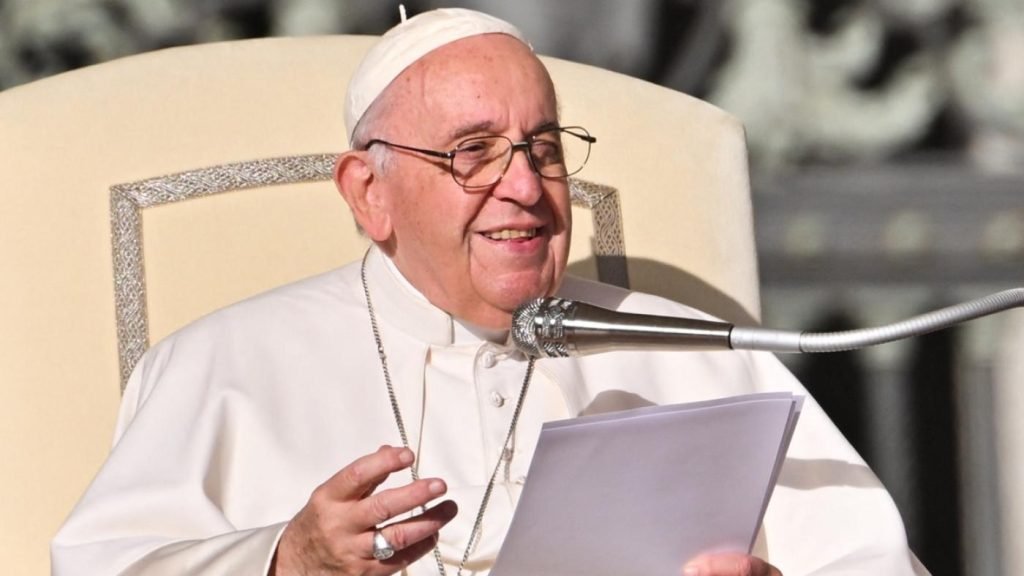
As Pope Francis visits the DRC and South Sudan, we take a look at previous papal voyages to the continent.
Pope Francis is visiting the Democratic Republic of the Congo and South Sudan, his fifth trip to Africa since being elected head of the Catholic Church in 2013.
The 86-year-old had to postpone the trip last year after suffering knee problems. But he was determined to undertake the visit, which will bring to 10 the number of African countries he has visited.
1960: Uganda
In the 1960s, popes didn’t travel much outside Vatican City. Pope Paul VI bucked the trend and became the first reigning pope to visit Africa.
It was a major event when he visited Uganda in 1969. Among other activities, Paul VI made a pilgrimage to the Uganda Martyrs Shrine Namugongo. During his visit, twenty-two Catholic martyrs were canonised.
Pope Paul VI standing in an open car waves to the crowd jamming the road to welcome him to Africa, accompanied by Archbishop of Kampala Emmanuel Kiwanuka Nsubuga, right, in Kampala, Uganda [File:AP]
Pope John Paul II
Pope John Paul II travelled widely throughout Africa during his more than 26-year pontificate. His first tour was in 1980.
1980: The Democratic Republic of the Congo, the Republic of the Congo, Kenya, Ghana, Burkina Faso, and Ivory Coast
During his first African tour, he visited six countries in 11 days. At the time the Democratic Republic of the Congo was known as Zaire and Burkina Faso was known as Upper Volta.
In Ouagadougou, the capital of Upper Volta, he made an appeal for international assistance for the country as it suffered a devastating drought. The donations received set in place the foundations for the establishment of the John Paul II Foundation for the Sahel in 1984.
During his trip, he reportedly criticised Marxism as an ideology and welcomed the religious enthusiasm he encountered.
On his last day, he also said: “There is a great temptation to demolish instead of building, to procure weapons at a great price for populations that need bread, to want to seize power – sometimes confronting one ethnic group with another … while the poor sigh for peace, succumb to the desire for profit benefitting a privileged class.”
1982: Nigeria, Benin, Gabon, and Equatorial Guinea
John Paul II’s second tour took place in February 1982, nine months after an attempt on his life.
In Benin where church-state relations were rocky, he listened as President Matthieu Kerekou delivered a lecture on ‘the socialist struggle’, according to the UPI news agency. He then celebrated mass for approximately 20,000 people at the stadium in Cotonou.
After five days in five Nigerian cities, including Lagos and Onitsha, the pope said the visit left him with “‘an unforgettable memory of a country which is a credit to Africa, to the world and to the church of Jesus Christ”.
In the northern city of Kaduna, he called for unity at a gathering of Muslim religious leaders, saying: “All of us, Christians and Muslims, live under the sun of the one merciful God.”
1985: Togo, Ivory Coast, Cameroon, Central African Republic, Democratic Republic of the Congo, Kenya, Morocco
This third tour of Africa was in August 1985, and his 27th trip outside Italy.
During this tour, he dedicated the biggest church in the world, the Basilica of Our Lady of Peace in Yamoussoukro, the capital of Ivory Coast. During his visit to the country five years earlier, he had blessed the foundation stone as construction began.
In a homily in Lome, the Togolese capital, he said he wanted to preach a faith that was ”authentically Christian and authentically African” in response to the matter of Catholicism adapting to traditional African practices.
He ended the tour with a plea to Muslims and Christians to put aside their differences and work together to create a better world.
1988: Zimbabwe, Botswana, Lesotho, Eswatini, Mozambique
During this trip, Pope John Paul II arrived in the Kingdom of Lesotho before a bloody shootout between police and gunmen who hijacked a busload of nuns and children while demanding to see the pope.
The pope arrived in Lesotho eight hours behind schedule and just 20 minutes before the tense hostage drama was resolved. One hostage died and eleven others were wounded but the others were rescued.
According to reports, the religious leader condemned apartheid in South Africa during this trip – in Lesotho.
“A civilization of justice, peace and love mean recognition of the dignity of each human being,” he was quoted as saying. “It means each human being can exercise fundamental rights without restrictions or limitations supposedly justified by racial segregation or by social discrimination.”
He also visited eSwatini, then still known as Swaziland.
1989: Madagascar, Reunion, Zambia, Malawi
This was his fifth trip to Africa as a Pope and his 41st trip outside Italy.
According to reports, his interest in Africa was driven largely by the rapid expansion of the Church during those years. Vatican sources said the church gained 2.5 million new adherents in Africa in 1989 alone.
There was also the beatification of Victoria Rasoamanarivo – a member of the Malagasy elite who encouraged Catholica communities at a time when Christianity was outlawed in the country – as a saint in Antananarivo, Madagascar.

